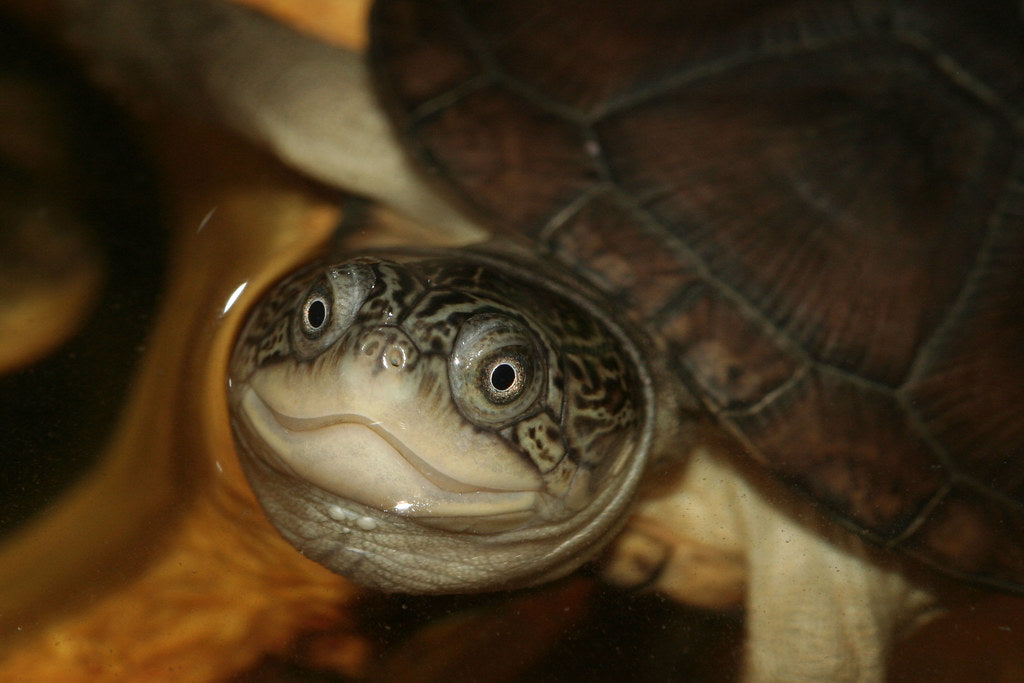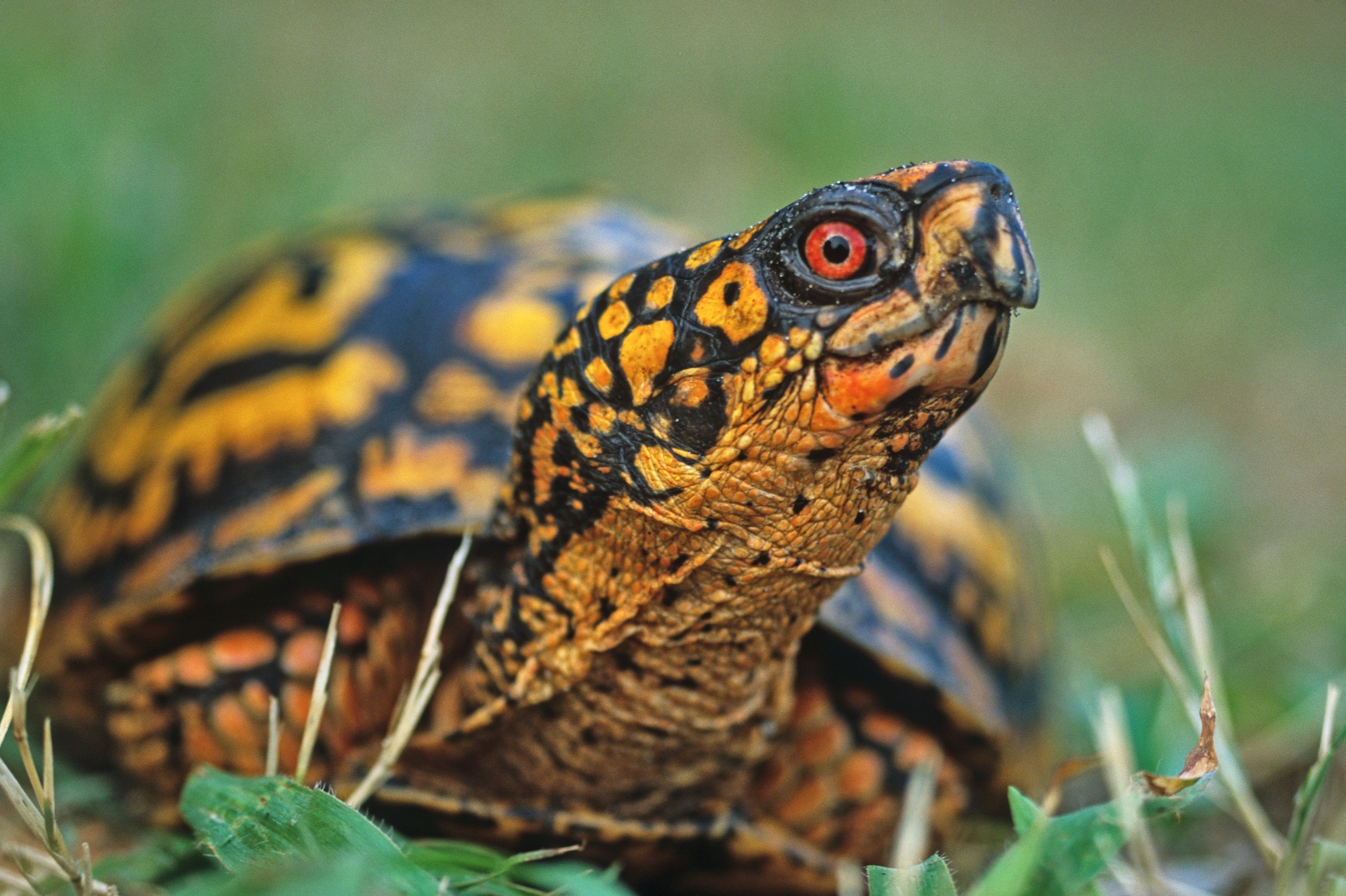The African sideneck turtle (Pelusios casteneus) is also known as the West African mud turtle. They are a large, semi-aquatic, diurnal reptile with populations in western and central Africa. They are highly adaptable, found in a variety of freshwater habitats including swamps, marshes, rivers, ponds, and even mud holes.
African sideneck turtles have an average adult length of 9-11”, with females being larger than males. They have large heads, smooth shells, semi-webbed feet, and two small, stubby barbels under the chin. Coloring is generally medium to dark brown and fairly uniform, with pattern only found on top of the head.
African sideneck turtles are well-known for being hardy, personable, and generally doing well in captivity. However, due to their size, they are at least intermediate-level pet reptiles. With good care, they can live up to 50 years.
How much space do African sideneck turtles need?
African sideneck turtles are large and fairly active, and they’re also amphibious, so they need an enclosure that will appropriately accommodate their preferred lifestyle. The minimum for appropriately keeping one adult African sideneck turtle is 90-110 gallons of water, no deeper than 1.5x the length of the turtle itself. This is just the minimum, and providing a larger enclosure is both beneficial and appreciated.
African sideneck turtles tend to do well when housed outdoors where local climate permits, even if it’s just during part of the year (these turtles do not hibernate). This is a convenient way to provide your turtle with a generously-sized pond and “free” heating and lighting. If housing your African sideneck turtle outdoors, make sure that the pond is no deeper than 1.5x the length of the turtle, and there is a retaining wall at least 18” tall and buried at least 6” into the ground to prevent potential escape.
It’s best not to house multiple African sideneck turtles in the same enclosure, as they can be aggressive toward other turtles in their “territory.” An exception can be made for particularly large ponds.
Do African sideneck turtles need UVB?
African sideneck turtles require regular exposure to high-quality UVB in order to maintain optimal health and wellbeing. Providing UVB lighting to your turtle gives them all of the vitamin D that their body needs, stimulates better appetite and activity, and strengthens the immune system, as well as other benefits.
The best UVB bulbs for African sideneck turtles are:
- Zoo Med Reptisun T5 HO 5.0
- Arcadia Forest 6%
The UVB bulb should be half the length of the enclosure and housed in a reflective fixture like the Arcadia ProT5 or Vivarium Electronics. Place the lamp close to the heat lamps, about 13-14” above the basking platform.
It’s also a good idea to provide a strong LED or T5 HO 6500K daylight lamp for additional illumination. This helps better replicate daylight and is also good for any live plants you may be using.
UVB bulbs decay over time, so don’t forget to replace your bulb every 12 months to maintain good performance. If you are housing your turtle outdoors in an appropriate climate, supplementary lighting is not required.
Lights should be on for 12 hours/day.
What basking temperatures do African sideneck turtles need?
African sideneck turtles are ectotherms, which means that they rely on the variable temperatures of their environment to help regulate their metabolism and stay healthy.
The basking platform should offer high temperatures of around 95°F, and the water should stay under 85°F, but no cooler than 70°F. Juveniles may require higher water temperatures of 80-85°F. Measure basking temperature with a digital probe thermometer, and water temperature with a high-quality aquarium thermometer.
A good way to warm the basking area is with a couple of halogen flood heat lamps clustered on one side of the enclosure and positioned over a sturdy basking branch or rock. Do not use ceramic heat emitters (CHEs), red bulbs, or blue bulbs, as these are not as effective. Increase the wattage if they’re too cool, and use a plug-in lamp dimmer if they’re too warm.
If you need to heat the water, use a high-quality aquarium heater rated for at least the maximum volume of water in the enclosure.
If you are housing your turtle outdoors, supplementary heating should not be required. However, African sideneck turtles are a tropical species and do not hibernate, so if your area experiences cold winter temperatures, they will need to be housed indoors during this time.
How do you maintain the water in an African sideneck turtle aquarium?
African sideneck turtles are semi-aquatic, which means that most of the enclosure should be water. This water must be kept clean at all times in order to keep your turtle healthy (and to keep the aquarium attractive). The most efficient way to do this is with a combination of excellent filtration and regular water changes.
Aquatic turtles are fairly messy creatures, so you will need a canister-style filter capable of handling at least 2-3x the amount of water in the enclosure. So, if you have an aquarium or pond with 110 gallons of water, you will need a filter rated for at least 220 gallons of water. Don’t settle for the cheapest filter you can find — this is one aspect of your turtle’s enclosure not to skimp on!
Once every 1-2 weeks, remove and replace approximately 30% of the aquarium/pond’s total water volume. This helps minimize buildup of toxic compounds in the water that a filter is unable to resolve. To make the job easier, use a siphon or water pump.
Both indoor and outdoor turtle ponds require filtration and water changes.
What decor can you use in a African sideneck turtle aquarium?
The most essential piece of “decor” you will need in your turtle’s enclosure is going to be a basking platform. Ideally, this should be a partitioned-off area of land where the turtle can climb out of the water, bask, explore, and burrow. If that is not possible, securely stacked rocks, a large piece of wood, or a commercially-available turtle basking platform can be used as a basking location. The turtle should be able to easily climb onto the platform, and be able to remove its entire body from the water.
Aside from the basking area, there are additional ways you can increase the enclosure’s functionality and general attractiveness. Here are some ideas:
- live/artificial plants
- driftwood
- hollow logs
- fine-particle substrate (ex: sand)
Make sure your turtle has access to places where it can hide from view as needed.
What do African sideneck turtles eat?
African sideneck turtles are omnivores, which means that they need to eat a balanced diet of both plant- and animal-based foods to get the nutrition that they need. Here is a general feeding schedule to follow:
African sideneck turtles younger than 1 year:
- 50% protein / 50% vegetables
- protein food daily
- vegetable food daily
- turtle pellets every other day
African sideneck turtles older than 1 year:
- 25% protein / 75% vegetables
- protein food 1-2x/week
- vegetable food daily
- turtle pellets 2-3x/week
Offer as much animal-based food as your turtle will eat in 5-10 minutes. A portion of chopped/shredded vegetables should be roughly the same size as the turtle’s shell. A portion of pellets should be roughly the same size as the turtle’s head.
Animal-based foods for African sideneck turtles: crickets, earthworms, dubia roaches, freeze-dried shrimp/krill, frozen bloodworms, silkworms, snails, guppies, mollies, platies, mosquito fish
Vegetable foods for African sideneck turtles: collard greens, dandelion greens + flowers, endive, green leaf lettuce, kale, red leaf lettuce, romaine lettuce, raw grated squash, carrots, green beans, raw grated sweet potato
Pellets for African sideneck turtles: Omega One Juvenile Turtle Pellets, Omega One Adult Turtle Sticks, Tetra ReptoMin, Zoo Med Natural Aquatic Turtle Food, Mazuri Aquatic Turtle Diet
Do African sideneck turtles like to be handled?
As a general rule, turtles do not like to be handled. However, African sideneck turtles do tolerate it better than most. They rarely bite, preferring to withdraw instead. That being said, it’s best to keep the handling to a minimum.
If you would like to interact with your turtle, try hand-feeding it with a pair of feeding tongs.
*This care sheet contains only very basic information. Although it’s a good introduction, please do further research with high-quality sources to obtain additional information on caring for this species.
"Pelusios castaneus" by Laurent Lebois © is licensed under CC BY 2.0



Leave a comment
This site is protected by hCaptcha and the hCaptcha Privacy Policy and Terms of Service apply.